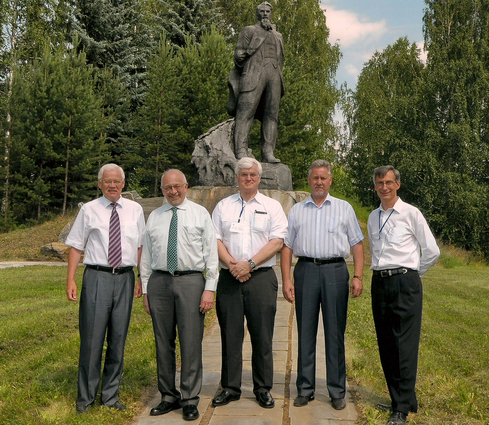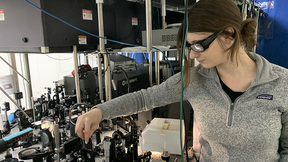LLNL, LANL, Sandia directors visit Russian laboratories
 (Download Image)
(Download Image)
Photo taken during a visit to the city of Snehzinsk and VNIITF in front of a statue of Igor Kurchatov, who was a Soviet nuclear physicist and widely known as the director of the Soviet atomic bomb project. Left to right: Georgiy Rykovanov, chief scientist, former director VNIITF; Paul Hommert, director, Sandia National Laboratories; LLNL Director Parney Albright; Mikhail Zheleznov, acting director, VNIITF, and LANL Director Charlie McMillan.
LLNL Director Parney Albright was accompanied by Bruce Warner, principal associate director for Global Security, and Mona Dreicer, deputy program director for Nonproliferation and Arms Control, from Livermore. The New Mexico group included LANL Director Charlie McMillian, Terry Wallace, principal associate director for Global Security and Nancy Jo Nicholas, program director for Nuclear Nonproliferation and Security, as well as SNL Director Paul Hommert, Jill Hruby, vice president for Energy, Nonproliferation and High-Consequence Security, and Wendy Cieslak, director for Nuclear Weapons Science and Technology. Representing NNSA were Don Cook, deputy administrator for Defense Programs, and Anne Harrington, deputy administrator for Defense Nuclear Nonproliferation. Two Russian language interpreters also accompanied the group.
"It was quite a trip," Dreicer said. "We visited five institutes in four cities in one week." The Livermore group flew to Moscow, where they met up with the rest of the U.S. contingent and NNSA representatives. From there, they took a bullet train to Nizhney Novgorod, where they visited the Research Institute for Measuring Systems Research (NIIIS), a leader in radio-electronics and control systems, and the OKBM Afrikantov institute, a developer of nuclear power and propulsion systems. A Rosatom charter flight then took them to Sarov and the All-Russian Scientific Research Institute of Experimental Physics (VNIIEF), considered the counterpart to Los Alamos. After that, the group flew to Yekaterinburg, followed by a two-hour bus ride to Snezhinsk, home of the All-Russian Scientific Research Center of Technical Physics (VNIITF), the counterpart to Livermore. Then it was back to Yekaterinburg for a flight to Moscow, where they toured the All-Russian Scientific Research Institute of Automatics (VNIIA), a leader in neutron generators and radiation detection.
"The trip to and through Russia was very demanding," Warner said, "Eleven time zones, daily travel, long days of talks and tours and lots of pomp and circumstance. However, the messages were consistent: respect for each other's science and technology, cooperation in areas of mutual interest and benefit and interest in learning about each other's culture."
Dreicer agreed that understanding the culture is important for good international cooperation. "We learned a lot about Russia and the Russian labs on this trip. Sarov and Snezhinsk are still closed cities, and it required Medvedev's signature to enter the technical areas." When asked to compare LANL and LLNL with their Russian counterparts, Dreicer explained that the directors of VNIIEF and VNIITF are responsible for their entire cities, not just their laboratories. "They have to concern themselves with everything that goes into running a city in addition to the science and technology of their lab."
The formal laboratory directors meeting was held in Sarov on June 20 to discuss the results of recent scientific and technical collaboration and possibilities for additional collaboration. This gathering was part of a series of meetings between U.S. and Russian directors that dates back to 1992 and the lab-to-lab collaborations that were initiated following the collapse of the Soviet Union. The laboratory directors meetings were resumed in June 2011, when the five Russian lab directors met in Livermore and visited LLNL.
At the 2012 meeting, projects for collaboration were proposed in basic S&T as well as international security and energy research. Research would be conducted both in Russian and American facilities. Among the possibilities discussed were high-energy-density science experiments with NIF as well as collaborations on plutonium science, planetary defense (i.e., killer asteroids), mathematics and computer science, radiation detection and nuclear forensics and seismic event characterization. Warner noted that the laboratories at Sarov and Snezhinsk expressed particular interest in collaborating with their U.S. "sister" labs in laser technologies and inertial confinement fusion as well as nuclear detection and other nonproliferation-related S&T.
Moving forward, Rosatom and NNSA are preparing an intergovernmental agreement in the area of research and development in the sphere of nuclear physics and energy that will identify the Russian and U.S. facilities for carrying out joint research and provide the formal mechanism for the envisioned technical cooperation. The agreement is expected to be signed by the end of October, and the directors will meet again via video teleconference by the end of the calendar year. In the meantime, the Russians and Americans have designated points of contact who will develop specific project priorities for the various technical areas.
"Unlike the 1990s when the goal was cooperation for cooperation's sake," Dreicer explained, "we're trying to identify the best collaborative projects that advance science in areas that we're both interested in. And through this mutually beneficial technical cooperation, we can help promote an enduring relationship between our two countries."







